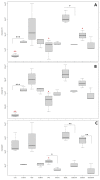Rapid Biotic and Abiotic Transformation of Toxins produced by Ostreopsis. cf. ovata
- PMID: 36547895
- PMCID: PMC9787646
- DOI: 10.3390/md20120748
Rapid Biotic and Abiotic Transformation of Toxins produced by Ostreopsis. cf. ovata
Abstract
The dinoflagellate Ostreopsis cf. ovata produces several families of toxic polyketides. Despite only a few field measurements of these phycotoxins in seawater and aerosols, they are believed to be responsible for dermatitis and the toxic inhalations reported during blooms of this species. Therefore, the stability of these compounds in seawater is essential to understanding the causes of these symptoms, however, this has never been assessed. In the current study, the optimization of a solid phase extraction (SPE) procedure was first performed to ensure the most efficient extraction of all phycotoxins known to be produced by this strain, including the recently described liguriatoxins. The SPE cartridge SDBL® under non acidified conditions offered the best option. The stability of the ovatoxins and the liguriatoxins under biotic and abiotic stress was assessed by exposing the spent medium of a culture of Ostreopsis cf. ovata to its bacterial consortium and natural sunlight. A rapid biotic transformation was detected for both families of compounds. When exposed to bacteria, the half-lives of the ovatoxins were reached before 10 h and at 36 h, 97% of these toxins had been transformed. The half-lives of the liguriatoxins were 10 h under these conditions. Photolysis (abiotic degradation) of the ovatoxins (T1/2 < 36 h) was faster than for the liguriatoxins (T1/2 > 62 h). Although none of the catabolites of these phycotoxins were thoroughly identified, an untargeted metabolomics approach combined with molecular networking highlighted the presence of several compounds exhibiting structural similarities with the ovatoxins. Additional work should confirm the preliminary findings on these potential ovatoxins’ catabolites and their biological properties. The rapid transformation of O. cf. ovata’s phycotoxins introduces questions concerning their presence in seawater and their dispersion in the sea spray aerosols. The compounds involved in the toxic inhalations and dermatitis often experienced by beachgoers may stem from the catabolites of these toxins or even unrelated and as yet unidentified compounds.
Keywords: Ostreopsis cf. ovata; catabolites; metabolomics; ova- and liguriatoxins.
Conflict of interest statement
The authors declare no conflict of interest.
Figures





References
-
- Ciminiello P., Dell’Aversano C., Fattorusso E., Forino M., Tartaglione L., Grillo C., Melchiorre N. Putative Palytoxin and Its New Analogue, Ovatoxin-a, in Ostreopsis Ovata Collected along the Ligurian Coasts during the 2006 Toxic Outbreak. J. Am. Soc. Mass Spectrom. 2008;19:111–120. doi: 10.1016/j.jasms.2007.11.001. - DOI - PubMed
-
- Pfannkuchen M., Godrijan J., Marić Pfannkuchen D., Iveša L., Kružić P., Ciminiello P., Dell’Aversano C., Dello Iacovo E., Fattorusso E., Forino M. Toxin-Producing Ostreopsis Cf. Ovata Are Likely to Bloom Undetected along Coastal Areas. Environ. Sci. Technol. 2012;46:5574–5582. doi: 10.1021/es300189h. - DOI - PubMed
-
- Tichadou L., Glaizal M., Armengaud A., Grossel H., Lemée R., Kantin R., Lasalle J.-L., Drouet G., Rambaud L., Malfait P., et al. Health Impact of Unicellular Algae of the Ostreopsis Genus Blooms in the Mediterranean Sea: Experience of the French Mediterranean Coast Surveillance Network from 2006 to 2009. Clin. Toxicol. 2010;48:839–844. doi: 10.3109/15563650.2010.513687. - DOI - PubMed
-
- Ciminiello P., Dell’Aversano C., Dello Iacovo E., Fattorusso E., Forino M., Grauso L., Tartaglione L., Guerrini F., Pezzolesi L., Pistocchi R., et al. Isolation and Structure Elucidation of Ovatoxin-a, the Major Toxin Produced by Ostreopsis Ovata. J. Am. Chem. Soc. 2012;134:1869–1875. doi: 10.1021/ja210784u. - DOI - PubMed

